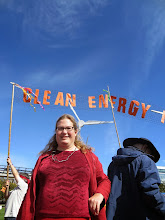Please donate to help us provide immediate relief, medium-term recovery, and long-term resilience in the face of future climate disasters.
 |
| In remote mountain communities, nearly every power pole was damaged. |
Relief
SGI is delivering solar-powered relief to the remote community of Ciales, which was impacted by the eyewall of the hurricane and experienced high winds, flooding, and loss of power. The most acute needs are people dependent on medical devices. We work with local partners such as the Catholic parish, who can identify the individuals most at risk who can benefit from battery powered devices powered by solar energy.
Children with asthma are at risk of hospitalization (or worse) without their medications, which are typically delivered through a nebulizer. Without power, plug-in devices can't be used, so we have provided battery powered nebulizers along with battery chargers and small solar panels.
 |
| This three-year-old boy has asthma along with other health problems. Now, solar energy charges the batteries for his nebulizer, providing life-saving medicine. |
Workers for the parish located 78 year old Don Diego living in a remote area of the mountains. His home had been severely damaged, and he had been unable to access FEMA aid because he had no government ID. Aid workers were able to get him an ID and at least clean up some of the debris around his house, while SGI provided a solar lantern for light at night.
 |
| 78 year old Don Diego with his solar lantern |
Recovery
In the medium term, households, businesses, aid distribution warehouses and community centers are working to install off-grid solar energy with battery storage. These systems can provide charging, communications, and refrigeration for medication. Even a single small installation can benefit dozens of residents without power.
Unfortunately, even if the money is available and the panels are paid for, bottlenecks in the port and skilled labor shortages can cause waits of a month or more for systems to be installed. In the meantime, residents must use generators, which have a high fuel cost and can break down. However, the promise of reliable power is worth the wait!
 |
| Off-grid solar installation in a remote mountain community |
The Puerto Rico Energy Commission has released preliminary rules for microgrids. A solar powered microgrid including its own batteries could connect to the larger grid, but disconnect and remain operational during power outages. The rules allow the microgrids to be owned by cooperatives - local community ownership!
SGI has hired two interns at the University of Puerto Rico to help plan a Solar Gardener Training. Our goal is to train 50 solar gardeners who will each begin the work to with local governments and organizations to develop shared microgrids in their communities. Puerto Rico can become a model for the rest of the world with an electricity system that is renewable, resilient, and community owned.
Donate to our GoFundMe campaign to support an intern or solar gardener in Puerto Rico

